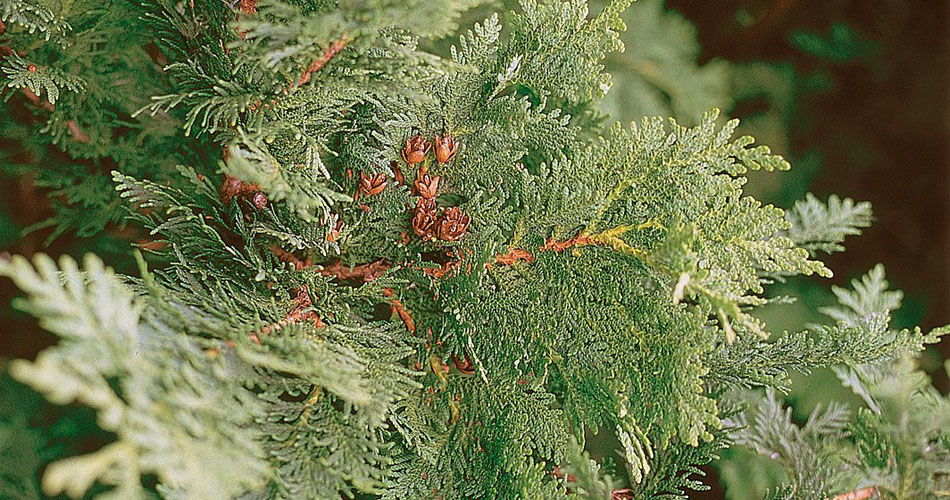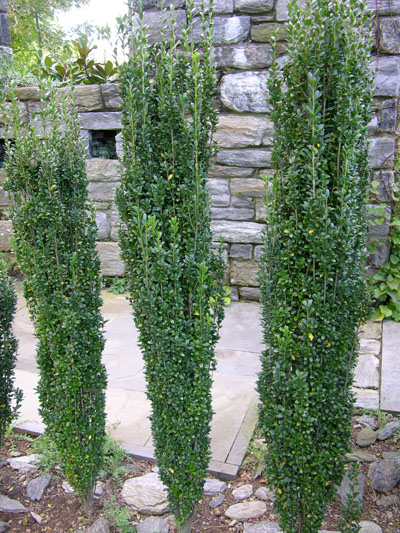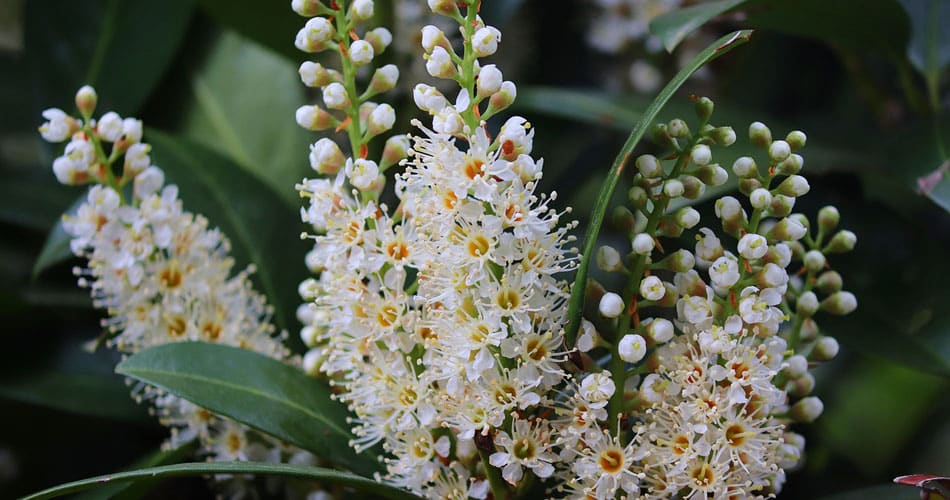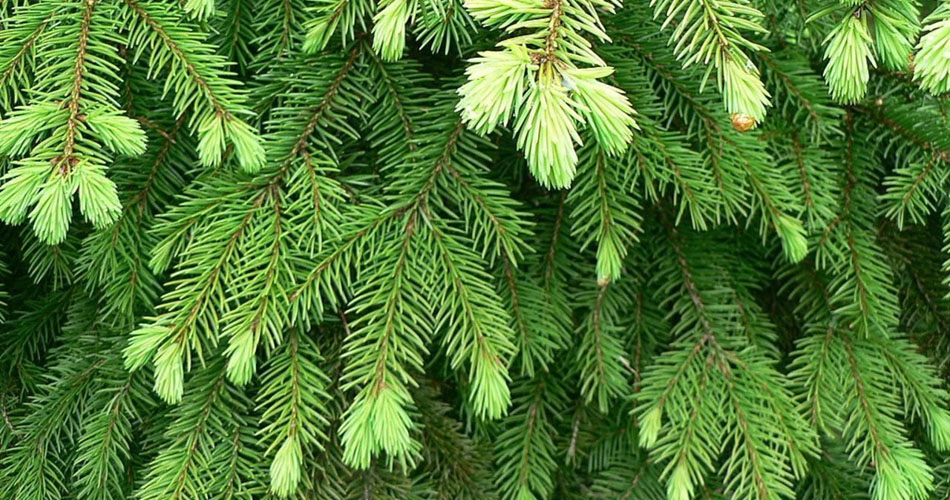Common trees like maples and oak trees get a lot of attention for the shade they cast in summer, their beautiful fall foliage, and the many other benefits they provide. But one thing they don’t do well is creating the kind of screening or privacy that a hedge provides.
What is a hedge?
Hedges are essentially a “living wall” and are often used in place of a fence or wall. Planting a number of trees or shrubs in a row to form a hedge can:
- define an area (think of all the formal gardens in Europe, for example),
- work as a property marker or boundary,
- block noise from a nearby road (and work as a sound barrier to reduce other noises),
- provide privacy from nosy neighbors and passers-by, and
- screen a not-great view (a brick wall or a neighbor’s yard, for instance).
Our favorite ways to use hedges are as a windbreak (saving you money on winter heating costs) and as a privacy fence.
However you decide to use a hedge, we have some tips for how to design it and where and when to plant it.
Where should you plant a hedge or privacy screen?
 Where you place a hedge depends on what you want it to do.
Where you place a hedge depends on what you want it to do.
For example, if you’d like to use it as a windbreak, you’ll need to plant on the north or northwest side of your house to block the cold winter winds. If it’s meant to screen your home from a busy street, the shrubs and/or trees will need to be planted between your house and the road.
Carefully consider the environment when deciding whether to use a hedge and which plants to use. While a fence can be added almost anywhere, plants used as a hedge, windbreak or privacy screen will need sunlight and water to survive. They will also need ample room to grow – both in width (so don’t plant too close to an existing structure) and height (check for overhead wires and overhanging trees or eaves). Also look for trees nearby (if the roots are where you want to plant, that might not work).
How tall should a hedge be?
The height of a hedge is particularly important if you’re trying to block something from view. The Arbor Day Foundation suggests putting a stepladder at the proposed location of your hedge to visualize how tall it needs to be. Then choose the type of tree or shrub for your hedge based on the height desired.
Which plants make the best hedge?
The “best” plants for hedging depend on your goals and aesthetic preferences. Some are dense (they completely block the view, as well as the sun), while others let light and wind through. Some are best trimmed regularly into a formal shape, while others look better with minimal pruning. Also, consider whether you want an evergreen hedge or one created with deciduous plants that lose their leaves in fall.
A hedge doesn’t have to be created from only one type of tree or shrub. Depending on your needs, a variety of plants can work just as well.
Can the same plants be used as a windbreak or privacy screen?
Some of the plants and shrubs typically used as a hedge can also be used as a windbreak or to create a privacy screen.
But it’s not always necessary to place plants in a row to achieve the desired effect. Larger trees or wider shrubs can often be placed individually and will still do a good job of blocking sightlines and creating a sense of privacy.
Our Most-Recommended Plants For Hedges, Privacy Screening & Windbreaks
Although there are many choices, there are some shrubs and trees that work better than others as a hedge, windbreak or privacy screen. Below are our top recommendations for homeowners in central New Jersey and eastern Pennsylvania.
Evergreen Shrubs
American Arborvitae (Thuja occidentalis)

Arborvitae trees and shrubs are commonly used as hedges and privacy screens
If you’re looking for significant height, consider American Arborvitae (Thuja occidentalis), which can grow 20 to 40 feet tall. The dark green foliage looks beautiful against a backdrop of winter snow and works well to block noise, views, or wind. It’s also a great backdrop for other plants and flowers.
In our part of the country, we recommend Thuja “Green Giant” Arborvitae. It’s a taller variety which normally grows to 60 feet, although you can keep it pruned much shorter. Deer love snacking on arborvitae but we’ve found that this cultivar is more deer-resistant than any others. You may also want to have some deer repellent plans in place if the shrub won’t be protected by a deer fence.
American Holly (Ilex opaca)

‘Sky Pencil’ Holly is taller and narrower than other types of holly bushes.
Photo by and (c)2006 Derek Ramsey (Ram-Man). Location credit to the Chanticleer Garden. – Self-photographed, CC BY-SA 3.0, https://commons.wikimedia.org/w/index.php?curid=1232391
Holly is another great option for privacy fences. The prickly edges of the holly plant can help deter unwanted guests from entering your yard, and if you get a female plant (with at least one male plant to act as pollinator), you can enjoy the sight of the red berries throughout the winter months. Depending on the variety, American holly can reach heights of 15 to 60 feet.
If you’d rather not deal with the prickly edges and/or you want something a bit taller, consider ‘Sky Pencil’ holly (Ilex crenata), which grows tall and narrow and has leaves with smoother edges. ‘Sky Pencil’ grows up to 10 feet tall and 2 feet wide, prefers full sun, and has black berries instead of the more familiar red.
Skip Laurel (Prunus laurocerasu ‘Schipkaensis’)
This common hedge plant grows quickly, up to two feet a year, so you can have a privacy screen in no time. It will grow to 6 to 10 feet tall and it is known for its small, waxy leaves. It does well in dappled shade, is deer-resistant, and tolerates many soil types. The dense foliage is easy to prune and small white flowers appear in spring.
 Skip laurel flowers in bloom
Skip laurel flowers in bloom
Evergreen Trees
Norway Spruce (Picea abies) and Serbian Spruce (Picea omorika)

Norway spruce needles
Norway and Serbian spruce trees can work as a hedge – or even on their own. Norway spruce is the fastest-growing type of spruce (it can grow up to 2 feet a year!) and, according to the Arbor Day Foundation, is an “ideal windbreaker.” Norway spruces can grow as tall as 60 feet, with a spread of around 25 feet, and prefer full sun.
Serbian spruce, on the other hand, grow rather slowly, depending on the circumstances. They will usually grow less than a foot each year. Serbian spruce trees have long, arching branches and a thin trunk. They’re best grown in partial shade.
We don’t recommend blue spruce – in our area, it’s particularly prone to cytospora canker. We also don’t recommend pine trees, as they tend to get leggy (the bottom branches fall or are pruned off, eliminating the privacy you planted them for) and deer love them.
Leyland Cypress (Cupressocyparis leylandii)
This is a fast-growing (2-3 feet a year!) evergreen that works well as a windbreak and/or as a property marker. You might also find it as a Christmas tree option at your local Christmas tree stand. They can grow up to 50 feet tall and like full to partial sun – they don’t do well in shade.
Deciduous Shrubs
Crapemyrtle (Lagerstroemia)

Choose dwarf or medium-sized varieties of crape myrtle
Crapemyrtle (also called crepe myrtle) works well as a privacy hedge. Choose a dwarf or medium variety that is known for branching out, and plant them 4-10 feet apart, depending on growing instructions. Proper pruning is vital when it comes to crape myrtles, so be sure you know how to prune them before committing to adding them to your yard.
Planting Advice
While it may be tempting to plant the trees or shrubs right next to each other, keep in mind that they will grow over time. To accommodate the mature size of each plant, leave some space between your windbreak trees or shrubs.
For shorter trees, leave at least 10 feet between each tree. If you’re planting multiple rows, leave 15-20 feet between each row. For taller trees (such as the ones we recommend above), leave 15 feet between each tree and 25 feet between each row.
Shrubs will need less space between them, depending on the type and how much they spread. Refer to specific planting directions for the type of shrub you choose.
We recommend planting the trees or shrubs in a zig-zag pattern instead of a straight line. This gives the plants more room to grow and will eventually form a wider, denser row.
Fall is a great time to plant trees or shrubs. The warm ground and cool air encourage root growth, helping plants get established before they go dormant in winter and before pests and diseases emerge in spring.
GET THE LATEST NEWS
Subscribe to the Organic Plant Care Newsletter and get timely and helpful tips and updates monthly.
There's no spam - we promise!





